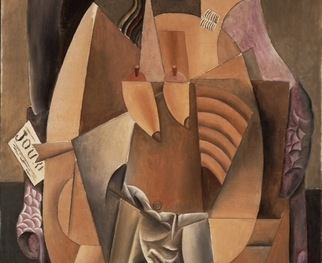(单词翻译:单击)

JUDY WOODRUFF:Next: a treasure trove of cubist art and a record gift for the Metropolitan Museum of Art in New York.
Margaret Warner has more.
For more on the collection and its significance, we turn now to Rebecca Rabinow, a curator from the Met's Department of Modern and Contemporary Art. And she joins us from San Francisco.
And, Ms. Rabinow, thank you for joining us.
What is the—how unusual and how important is this bequest, both as a body of work in and of itself, and also for the Met?
REBECCA RABINOW,Metropolitan Museum of Art: It's extraordinary in every possible way.
On the one hand, you have a collector who has really focused so intently and so in-depth at one particular moment, buying the best of the best. So it's an extraordinary collection. And in giving it to the Metropolitan Museum of Art, Mr. Lauder has transformed our holdings, certainly of 20th century art.
He understands that this was a big lack of the collection, and by giving us these extraordinary works, cubist works, we can really help start to tell some of those important stories of modern art. But he also understands that it is an encyclopedic museum. So we are able to put it in the context of art from other cultures and arts of other time periods.
So, from our point of view, this is a transformative gift of the highest caliber.
MARGARET WARNER:And help us understand cubism. It's oft been described, of course, as revolutionary. What was revolutionary in the way cubist artists portrayed the world?
REBECCA RABINOW:So, you're talking about Braque, Georges Braque, and Pablo Picasso, two young artists who were working in Paris.
In 1908, there was an exhibition of Braque's work at the gallery Kahnweiler, a gallery in Paris. And it was at that gallery that a critic coined the term cubism. He felt that Braque was taking apart the picture plane and turning shapes, using geometric shapes to reproduce objects of art in a sense.
By 1909, Braque and Picasso were inseparable. They became great friends. They went to each other's studios every day. They vacationed together. And they began to look at art and art's possibilities in an entirely new way. They began to emphasize that two-dimensional aspect of a painted surface.
They were interested in breaking up contours and creating a faceted surface, looking at one work of art from multiple points of view simultaneously. So what the cubists did was absolutely revolutionary for themselves, but also in the way it inspired other artists.
MARGARET WARNER:Let's take Picasso's Nude Woman in a Chair from 1909. How does that illustrate cubism as you just described it?
REBECCA RABINOW:That painting, which is a masterpiece in and of itself, about 3 feet tall, is a perfect example of how cubism bridged 19th century—late 19th century art into the 20th century, because Picasso was very interested in the art of Paul Cezanne. Cezanne had recently died. There was a retrospective of his work in 1907.
And what Picasso is doing in that painting is that he is looking at Cezanne's famous pictures of his own wife, Hortense, seated in an armchair. But now Picasso is starting to break apart the forms. And so it's clearly identifiable as a woman, and yet he's showing her from multiple perspectives simultaneously. He's starting to reduce or simplify parts of her anatomy into geometric forms.
So, that painting really in many ways is a wonderful link. It shows Picasso looking back to what came before and also looking forward to see his new direction.
MARGARET WARNER:Could any museum, even with a large budget for acquisitions, go out on the market today and acquire a collection of this kind of size and depth in one field?
REBECCA RABINOW:It would be absolutely impossible to replicate Mr. Lauder's collection. These important cubist works are simply not on the market, in private hands, because his collection is not only about fantastic works of art. He bought the best of the best.
But he was a scholar collector in many ways. He was interested not only in sort of the formal values, how these pictures look, how they function within an artist's career, but interested in them as objects as well and in history. So, his collection has works that passed through the most important cubist dealers' hands, the most important cubist collectors' works.
He has pictures in his collection that were exhibited in historic exhibitions, like the Armory exhibition of 1913, which introduced modernism to American audiences. So his collection is a collection of firsts. It's a collection of masterpieces. It is absolutely impossible to replicate, and we are just thrilled to be able to have it at the Met for the enjoyment of everyone.
MARGARET WARNER:And the public will get to see this next year in a special exhibition.
Rebecca Rabinow, thank you so much.
JUDY WOODRUFF:Watch a slide show of the donated works on Art Beat.


